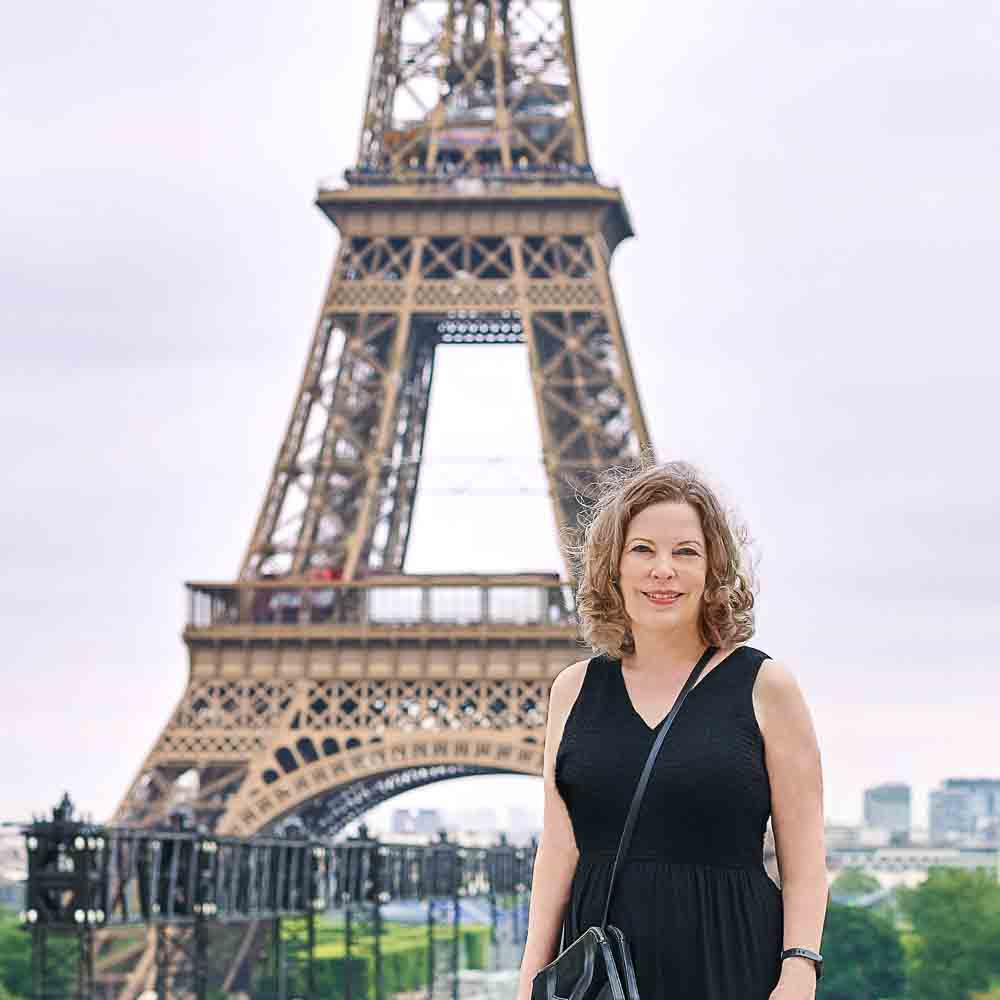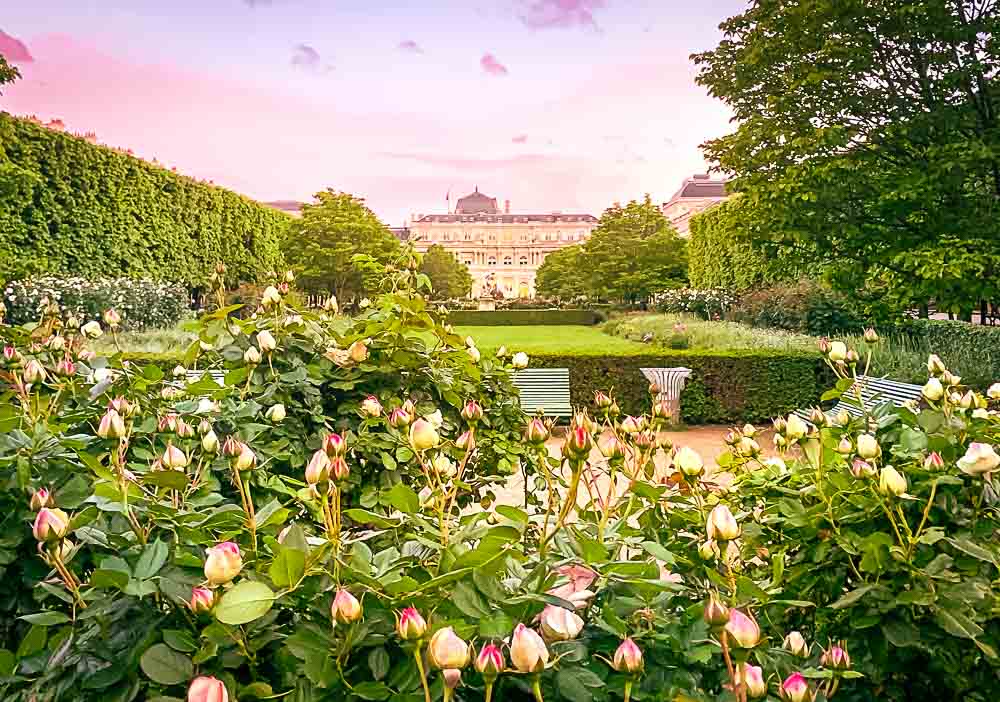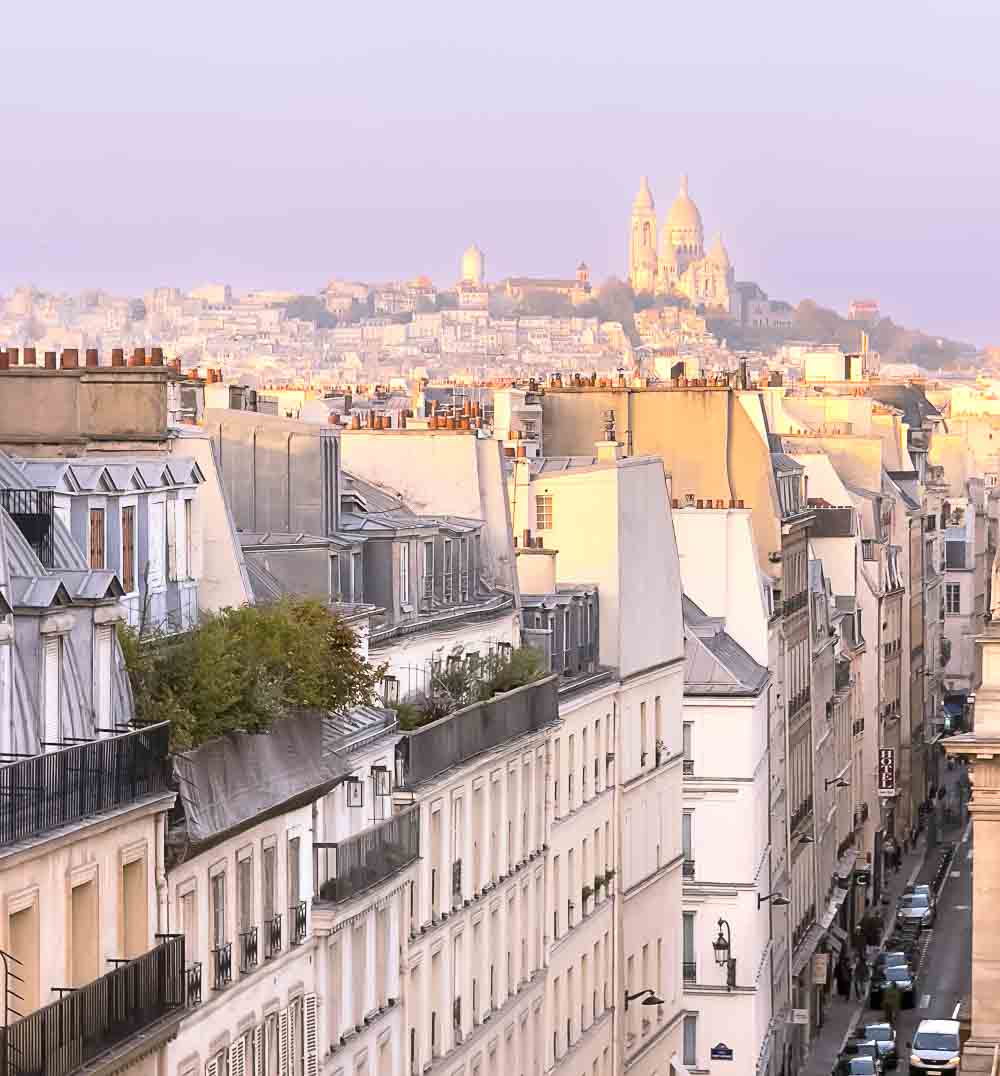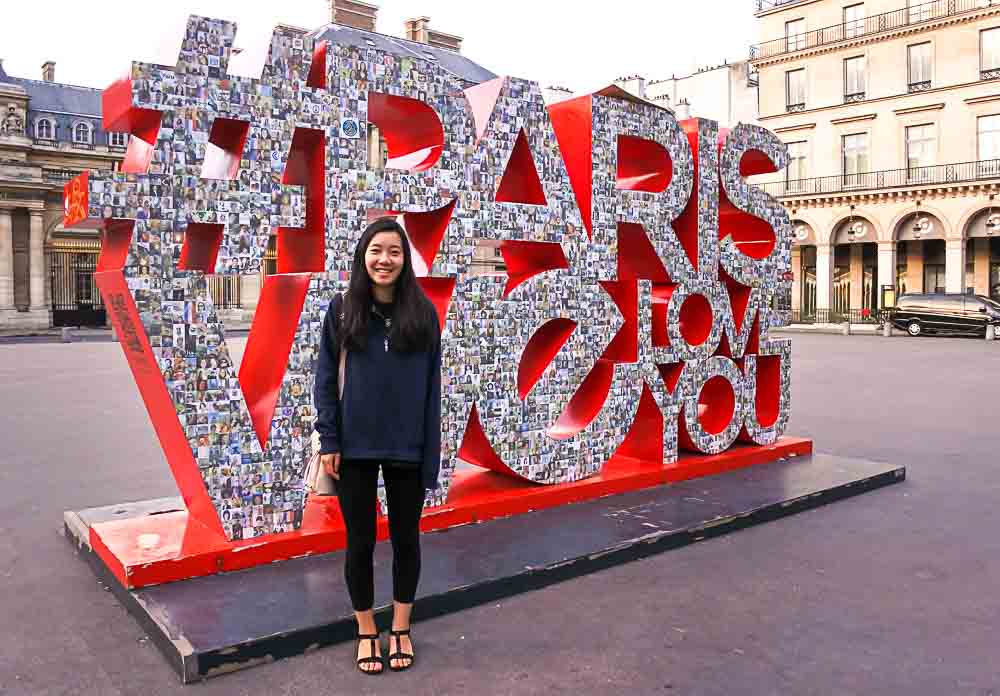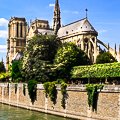Want to explore Île de la Cité, one of two attraction-packed islands in the Seine River at the heart of Paris?
You may already know Île de la Cité as the home of three magnificent world-famous medieval masterpieces - Notre Dame Cathedral, Sainte-Chapelle, and the Conciergerie - but it's also the birthplace of Paris and filled with lots of other interesting places for you to visit.
I like to visit Notre Dame at least once every time I'm in Paris, especially now that it's reopened, and also revisit the other attractions, yet I never get tired of exploring the island's layers and layers of history.
Almost 2,300 years ago, a Celtic tribe called the Parisii created a small settlement here, and since that time, Roman invaders, France's first kings, Medieval and Renaissance architects and builders, and the French Revolution have contributed to Île de la Cité's fascinating mix of history and charm.
Today, in addition to the three top medieval attractions, you can visit a historical flower market that's flourished here since the early 1800s, a haunting World War II memorial, beautiful but almost hidden parks, an archeological dig where you can see layers of Paris history, a square lined with lovely buildings built in the early 1600s by a French king, inviting bistros and boutiques, and other special places missed by many visitors.
Consider beginning your explorations by joining a small-group guided tour of the island. One of the best is the Île de la Cité Walking Tour, which also includes skip-the-line tickets and tours of Sainte-Chapelle and the Conciergerie, as well as an exterior visit to Notre Dame Cathedral (enter on your own after the tour if you want).
In this article, you'll find fascinating places to visit plus a map of Île de la Cité, tips for getting there, suggestions about where to stay nearby, and where to eat.
Top photo: Notre Dame Cathedral before the fire, (c) Paris Discovery Guide
Paris Discovery Guide is a reader-supported publication. When you buy through my links, I may earn a small commission at no additional cost to you. Merci beaucoup for your support!
15 Interesting Things to Do & See on Île de la Cité
Tour Île de la Cité By Foot or On Wheels
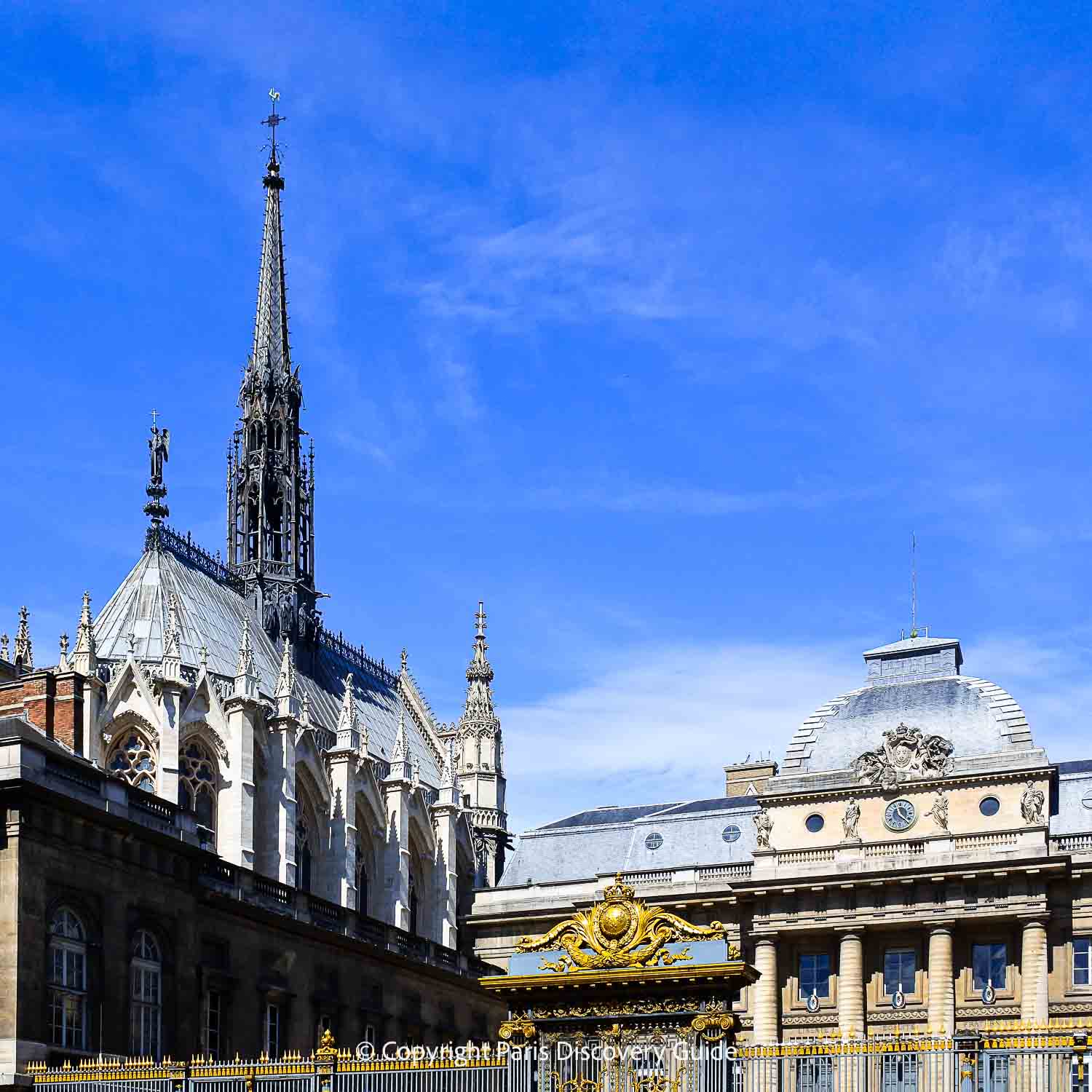
A popular way to get acquainted with Île de la Cité's famous and lesser-known attractions is to join a guided tour.
Whether you prefer to make the most of your time by visiting Île de la Cité with a local expert or you want a quick introduction to the neighborhood before exploring more on you own, these tours offer you a variety of fun and unforgettable experiences while seeing top attractions, learning about the island's history and lore, and even seeing other parts of Paris:
- Île de la Cité Walking Tour including Notre Dame - See the island, Sainte Chapelle, and the Conciergerie on this small group tour; includes skip-the-line tickets, and an exterior tour of the Cathedral
- Île de la Cité Walking Tour, Seine Cruise, & Skip-the-Line Sainte-Chapelle - Explore the neighborhood on this guided walking tour; get tickets to visit Sainte-Chapelle and take a Seine River cruise on your own
- Notre Dame Exterior Walking Tour with Sainte-Chapelle - Discover Notre Dame Cathedral from the outside, explore Ile de la Cité, and get an entry ticket to Saint Chapelle
- Classic Sites Tour by Vintage Citroen 2CV - See famous Paris attractions all over the city, including Notre Dame on Île de la Cité, on this 2-hour driving tour in a classic French car
- Charming Paris Nooks & Crannies Bike Tour - Explore Paris's most charming neighborhoods including Île de la Cité by bike on this fun tour of the city's top attractions
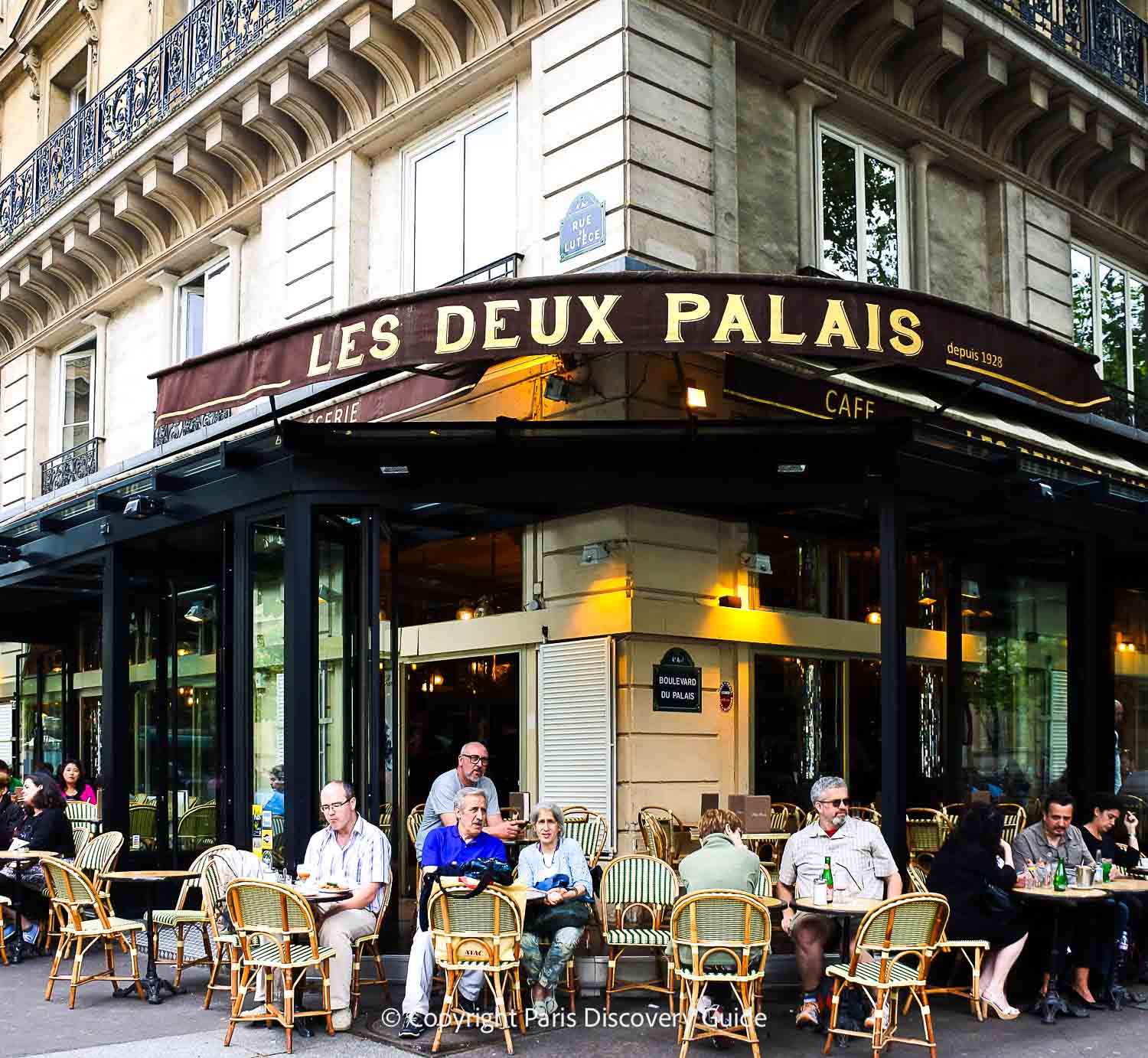
Fun fact about Île de la Cité: The island is split between two of Paris's 20 administrative districts. The island's western end is in the 1st arrondissement, and the eastern end is in the 4th.
Gaze at the Medieval Splendor of Notre Dame Cathedral & Schedule a Visit Inside
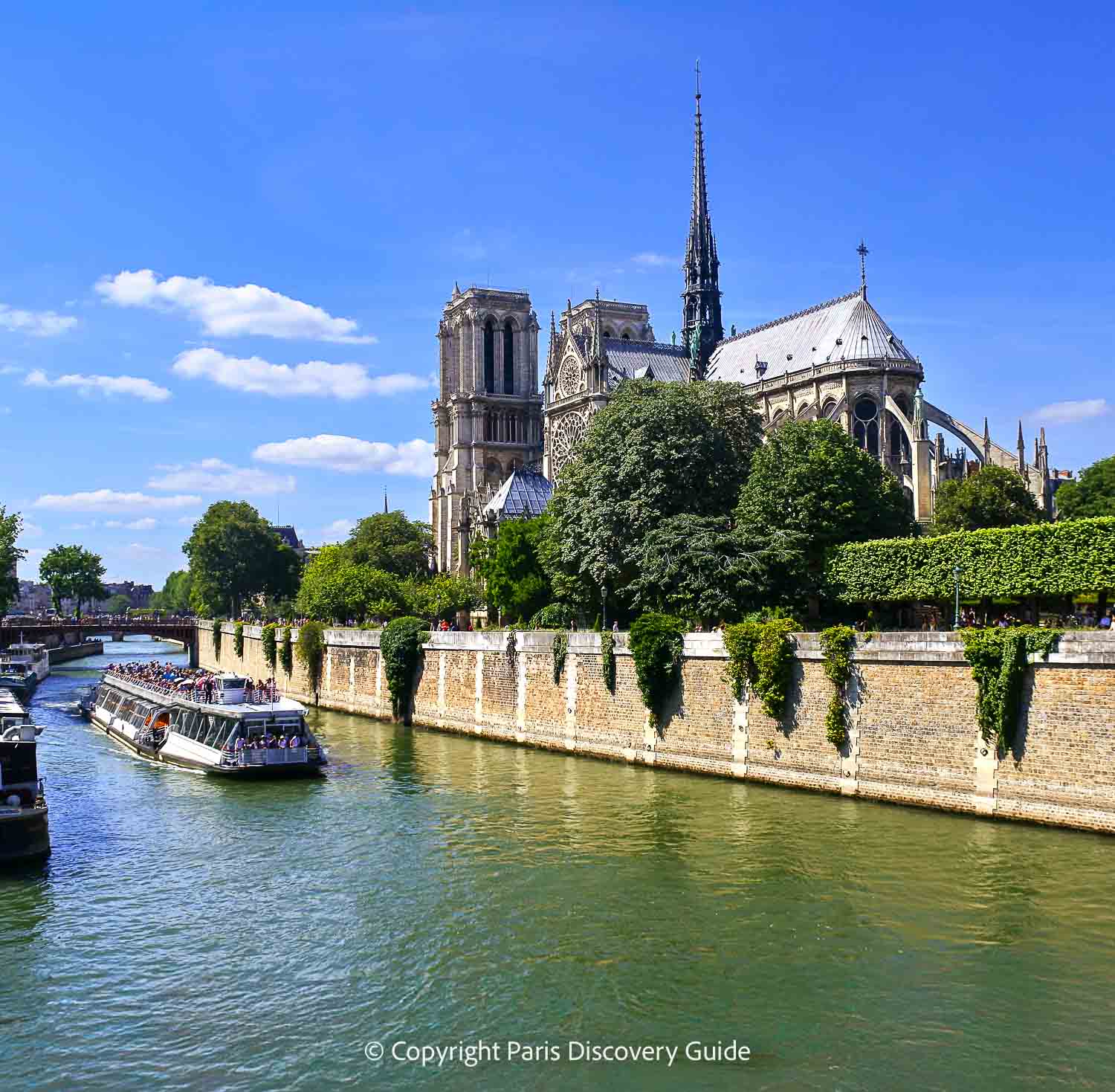
Notre Dame Cathedral - or in French, Notre-Dame de Paris, meaning "Our Lady of Paris) is one of the world's finest and most famous Gothic cathedrals, built between 1160 and 1260.
Notre Dame is the most important medieval monument in Paris, and certainly the most important attraction on Île de la Cité.
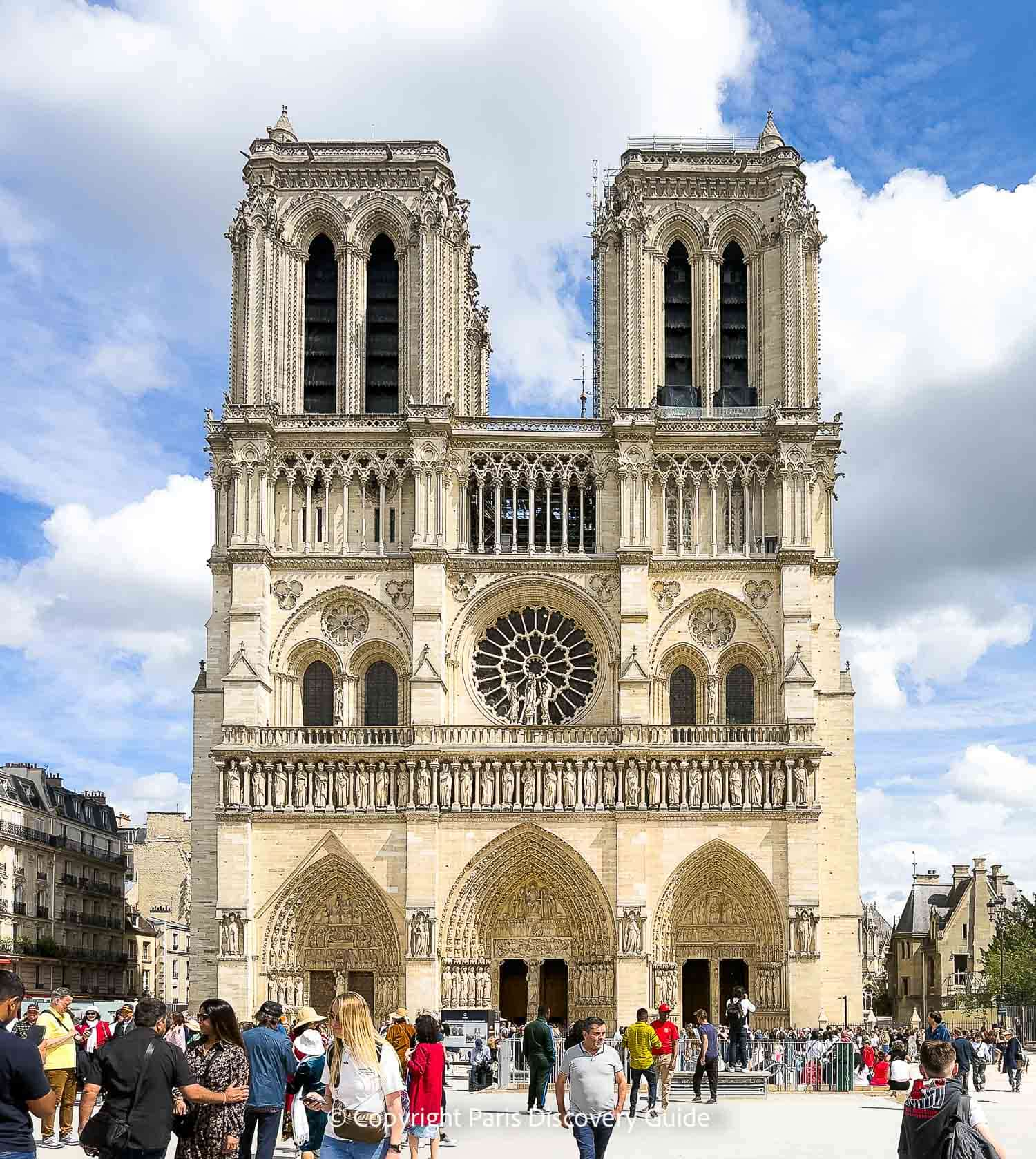
Although the cathedral always felt stunning before the fire, it's even more awe-inspiring now. Plus, the stones, stained glass, and everything else had to be cleaned after the fire and it is now filled with light.
The cathedral's flying buttresses and vaulted ceilings, gorgeous stained glass rose windows, superb (and enormous) pipe organ and bells, massive quantities of decorative sculpture including its famous gargoyles, priceless art and religious relics, and beautiful concerts are just a few of the many reasons to visit.
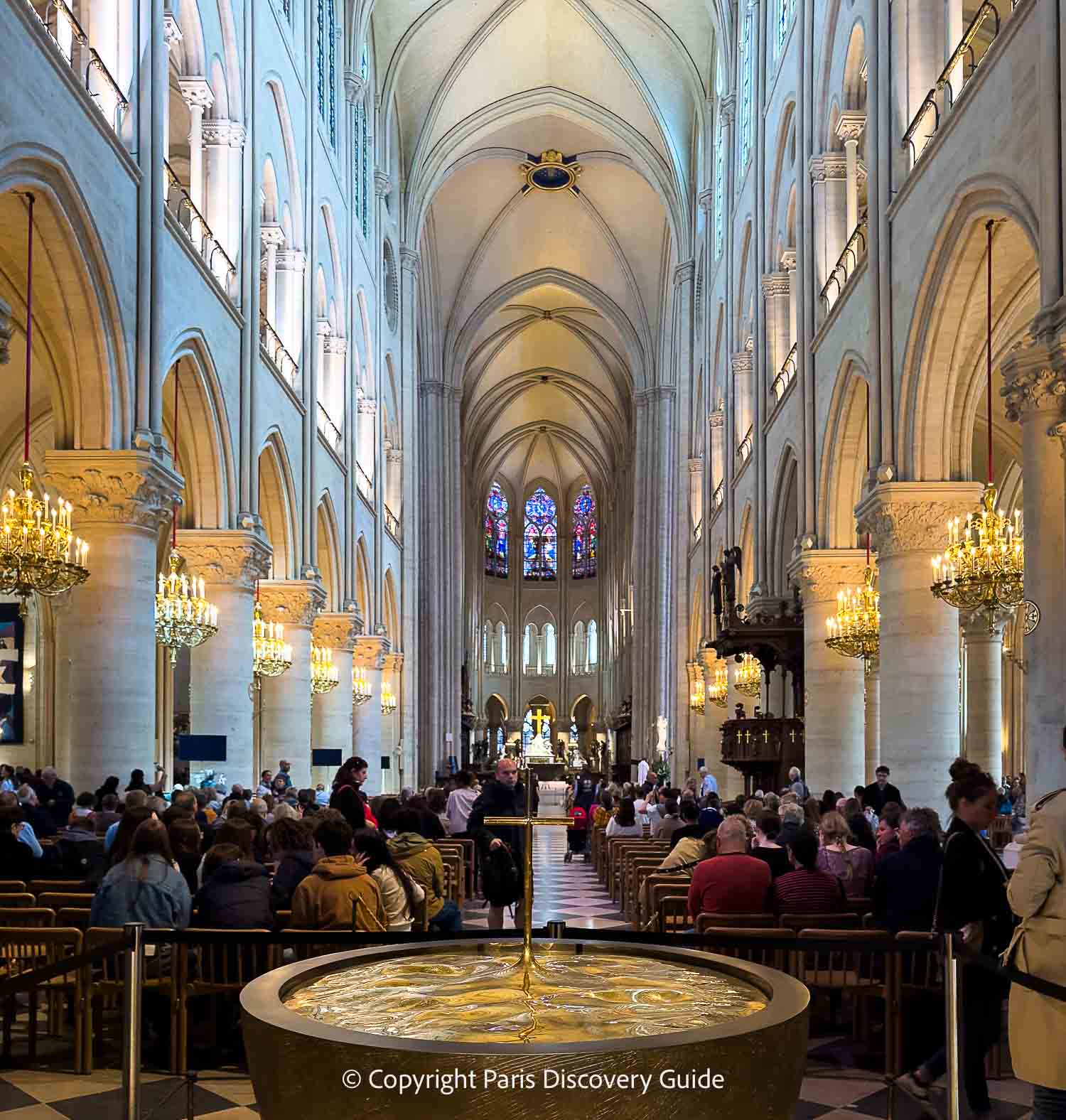
At the present time, you should always to get a free timed-entry ticket in advance of your visit through the Cathedral's online registration system. I do this, and I've never had more than a 2-3 minute wait as the line for those with tickets moves very quickly.
You can also go without a ticket and stand in line but should expect to potentially have a long wait, as crowd-control measures are in place to prevent the Cathedral from becoming too packed at any one time.
Based on what I've observed, you'll probably spend around 20-25 minutes waiting in the "no ticket" line - which honestly isn't bad compared with, for example, the Eiffel Tower - but why waste any of your time in Paris?
Although the Cathedral admits between 10,000 - 15,000/day, tickets on the Cathedral's website are still (after almost a year) filling up almost immediately. The Cathedral releases groups of tickets periodically throughout each day, so if you can't find any at first, just keep trying.
To learn more about the Cathedral's architecture, elaborate carvings, and history before or after your visit, join a 1-hour tour.
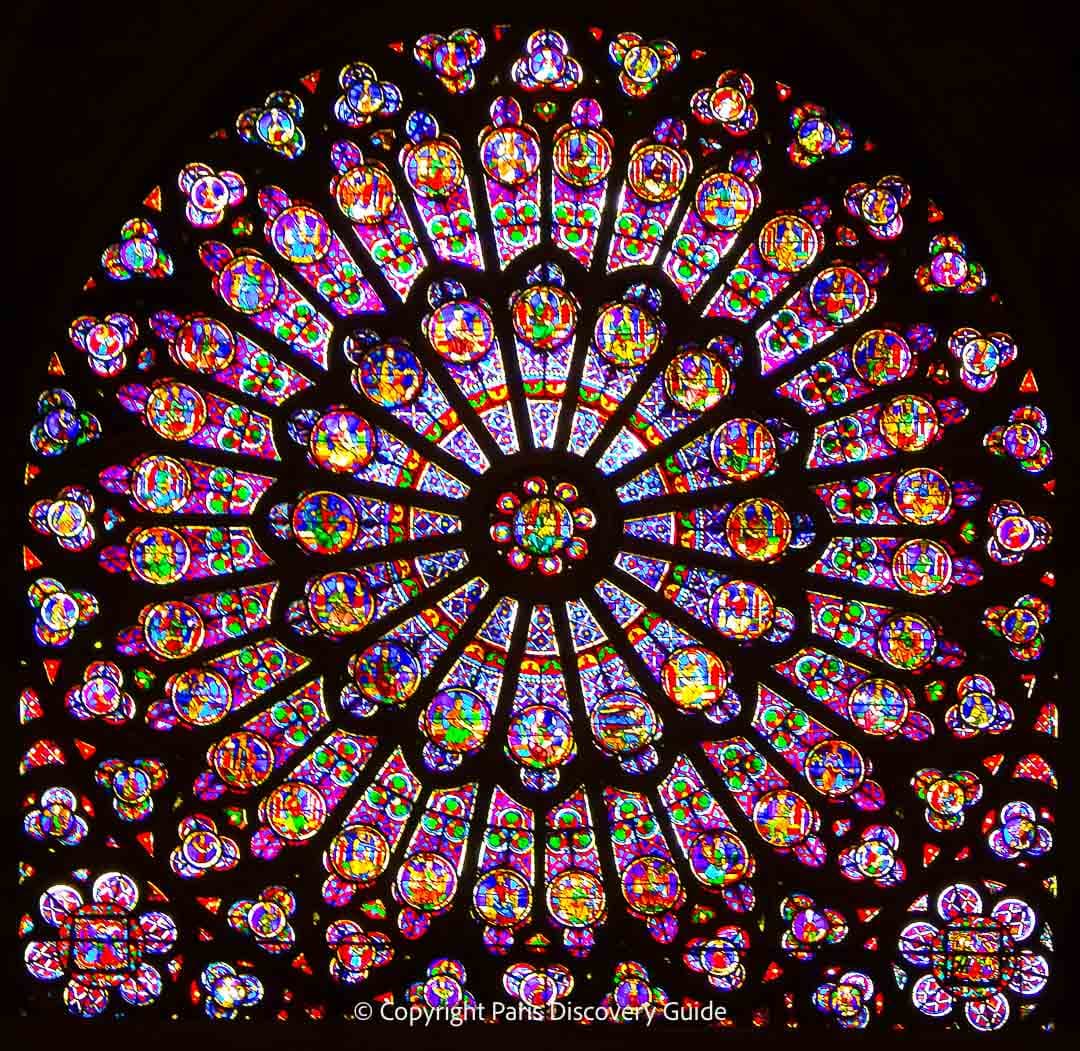
If you want to book a Seine cruise to see Notre Dame on your own, the hop-on hop-off Batobus is a good choice because you can cruise by as many times as you want, and of course get off the boat at the Notre Dame stop to see the Cathedral up close.
Finally, if you don't have a lot of time or want to combine seeing the famous cathedral with other activities, consider a 1-hour Seine River cruise, an evening Seine River cruise with dinner, or a combo ticket for a hop-on hop-off bus tour and Seine River cruise.
See Sweeping Paris Skyline Views from Notre Dame's Towers
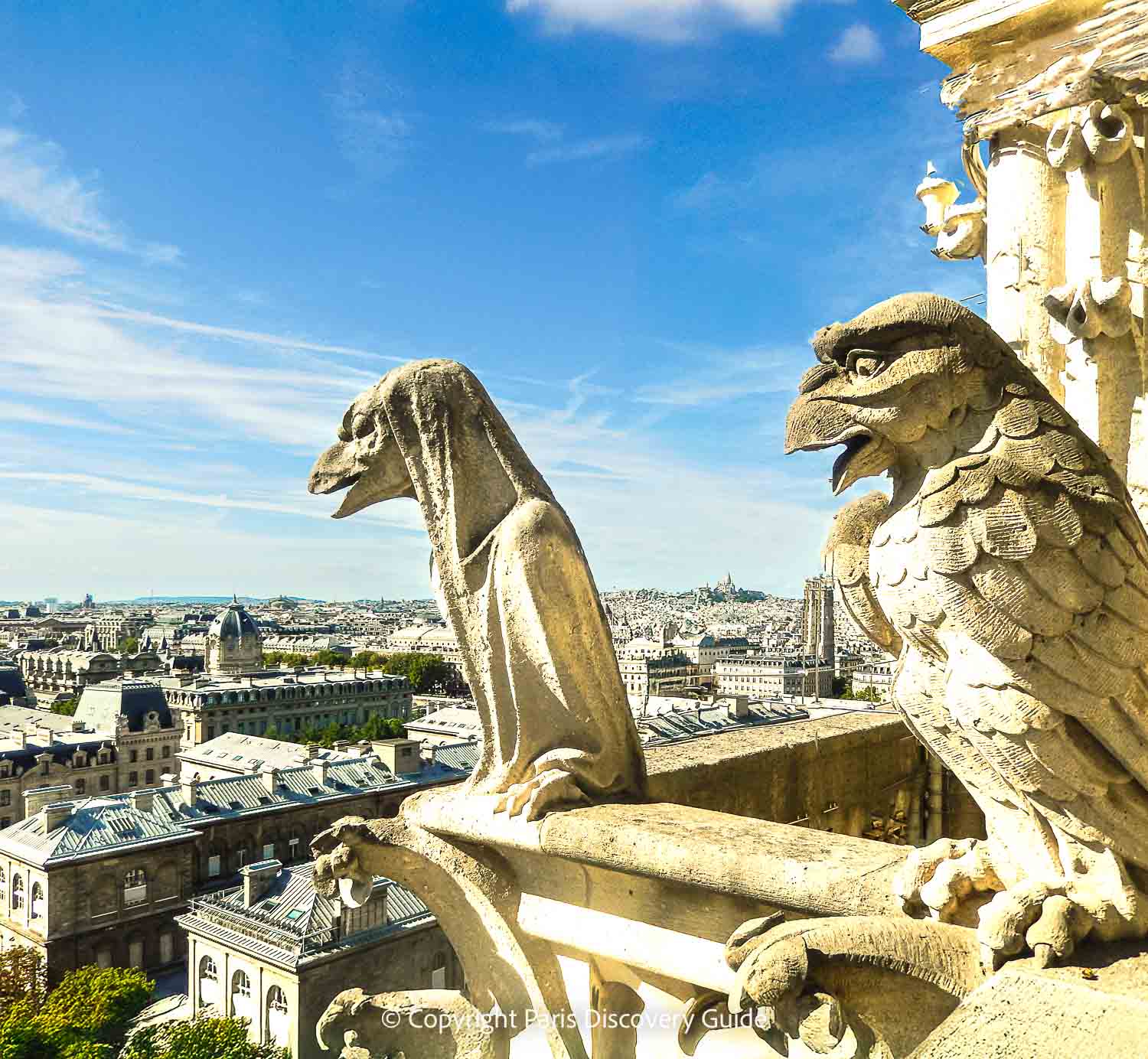
Exciting news: Notre Dame's Towers, with their sweeping views of the Paris skyline will reopen to visitors on September 20 as part of the 2025 Journées Européans du Patrimoine.
The tower tour path has been completely redesigned for an immersive experience, and is expected to last about 50 minutes. You'll start the tour in a room at the base of the South Tower where you'll get an overview of major phases of Notre Dame's history
Then you'll climb up 424 steps and pass through the belfry's roof on your way to the roof terrace 226 feet (69 meters) above ground where you can see panoramic views of Paris, the spire, and close-up encounters with the chimeras, gorgoyles, and other medieval sculptures and carvings adorning the world-famous Cathedral.
On your way down, you'll pass through a courtyard of cisterns, get a glimpse of the enormous wooden roof frame called "the forest," and enjoy an immersive sound show as you descend the North Tower's spiral staircase.
Because of the expected crowds, reservations will be mandatory (and no doubt extremely hard to get).
There's no word yet about an admission fee or hours - so stay tuned!
More about the Towers and other locations for viewing the Paris skyline
Soak Up Beauty & Hear a Concert in Saint Chapelle
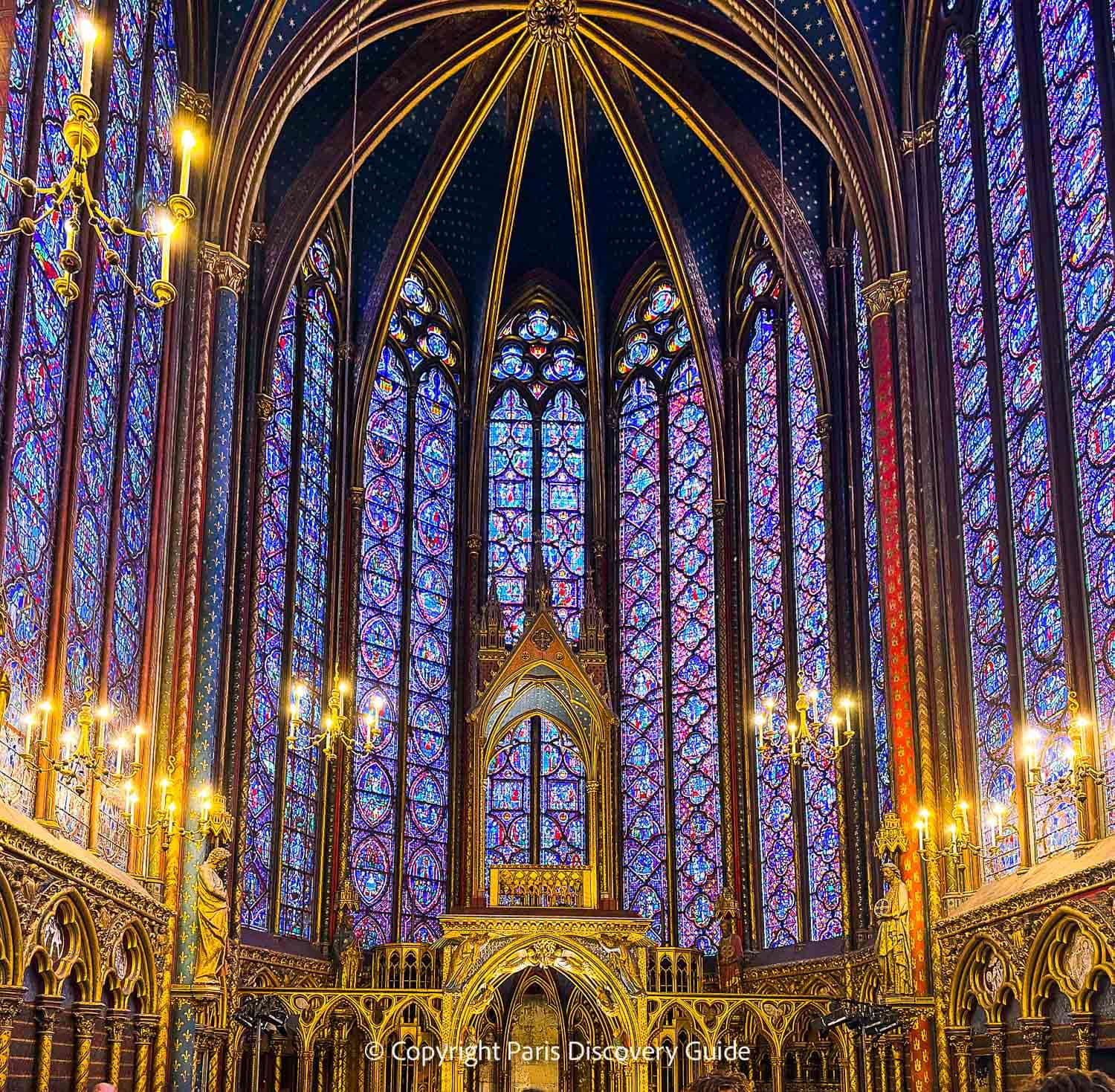
Famous for its dazzling medieval stained glass windows and candlelight concerts, Sainte Chapelle is another Gothic gem on Île de la Cité.
In a city filled with magnificent churches, the dazzling beauty of this small 13th century chapel built to house religious relics has no equal. I've been fortunate enough to visit here more than a dozen times, and I never fail to feel awestruck as I see the sunlight streaming through the huge stained glass panels.
You should always get an advance skip-the-line ticket because there's no guarantee you'll get in otherwise since tickets often sell out due to the chapel's small size.
Check availability:
If you're planning to visit for the first time, you'll get the most from your experience by joining a small group Île de la Cité Walking Tour which includes tours of Sainte Chapelle and La Conciergerie next door. Your guide will share highlights of Sainte Chapelle's history and architecture, and explain a few of the 1,113 scenes depicted in the chapel's 15 huge glass panels.
You can also get free admission when you have a Paris Museum Pass but make sure you book a time slot in advance.
Find out more about visiting Sainte Chapelle
Explore the Conciergerie: Medieval Palace, Reign of Terror Prison
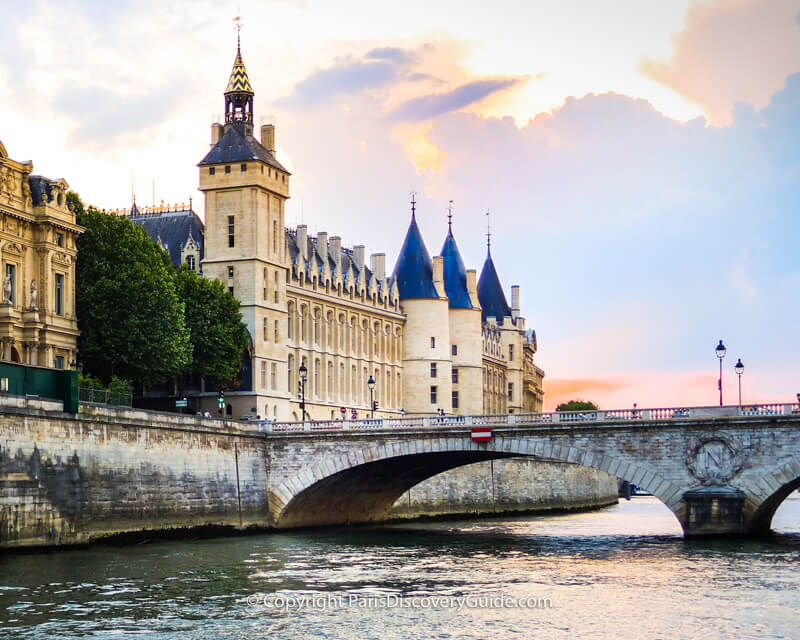
Many Paris visitors overlook the Conciergerie, Île de la Cité's third magnificent medieval attraction, in favor of Notre Dame and Saint Chapelle, its more famous neighbors. That's a pity because this UNESCO World Heritage site is a stunning example of 13th century secular Gothic architecture.
Aside from its spectacular soaring arches, vaulted ceilings, and immense spaces, the Conciergerie holds a special place history as the royal palace of the first French kings in addition to serving as a notorious Reign of Terror prison where Marie Antoinette spent her final days awaiting execution.
Best ways to see the Conciergerie:
- Get a Conciergerie timed-entry ticket online
- Save money with a discounted combo ticket + guided tour for the Conciergerie and Saint Chapelle, plus the outside of Notre Dame Cathedral
Find out more about why to visit the Conciergerie
Relax & Enjoy a Drink or Meal in Place Dauphine
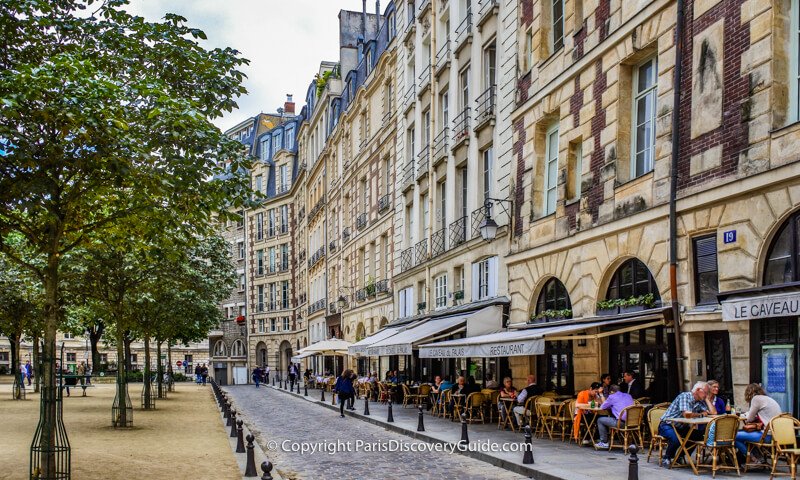
Almost hidden behind Sainte Chapelle and the Conciergerie are two special places that most Paris visitors miss - but you shouldn't.
The first one you'll come to is Place Dauphine, created by King Henri IV between 1607 and 1614 as one of his many projects to improve city life. You'll feel its charming and tranquility as soon as you enter the square from Rue de Harlay.
Stroll past the small book stores and shops tucked among the restaurants, enjoy a leisurely meal, or just find an empty park bench on the tree-filled gravel plaza and admire the (mostly) 17th century architecture and the occasional groups of Parisians playing boules, or pétanque (similar to bocce), under the trees.
When Henry IV decided to develop this bit of the island, he decreed (a perk of being king) that all the buildings surrounding the square must conform to the same design: two arcaded shops on the ground floor and two residential floors above, topped by an attic.
Through the centuries, owners have added floors and embellished the building's façades. Only two remain mostly unchanged from their early 17th century design.
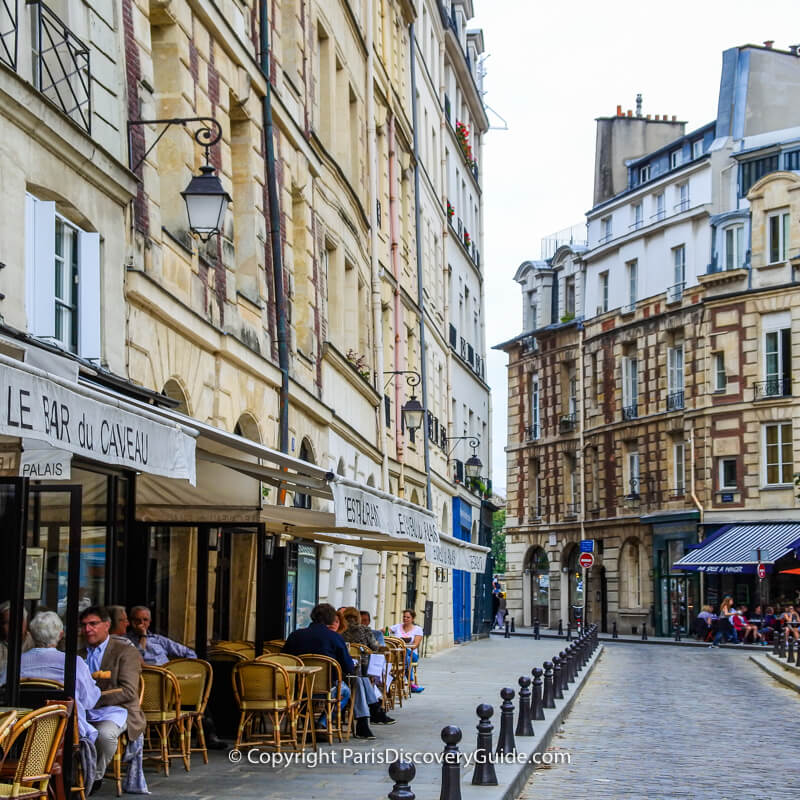
Want to see the two original buildings?
Look toward the west, where the buildings come almost together to form the point of a triangle. See the last house on each side, noticeably shorter than the others? That's what all the houses surrounding the square once looked like.
Now, walk through the gap between the buildings (it's wider than it looks in the photo), and you'll see three more things:
- Paris's oldest bridge, Pont Neuf, which connects Île de la Cité to the city's Right Bank and Left Bank,
- A large statue of Henri IV on horseback facing east toward Place Dauphine
- About 20 feet (7m) below, the second special place you should visit: Square du Vert-Galant.
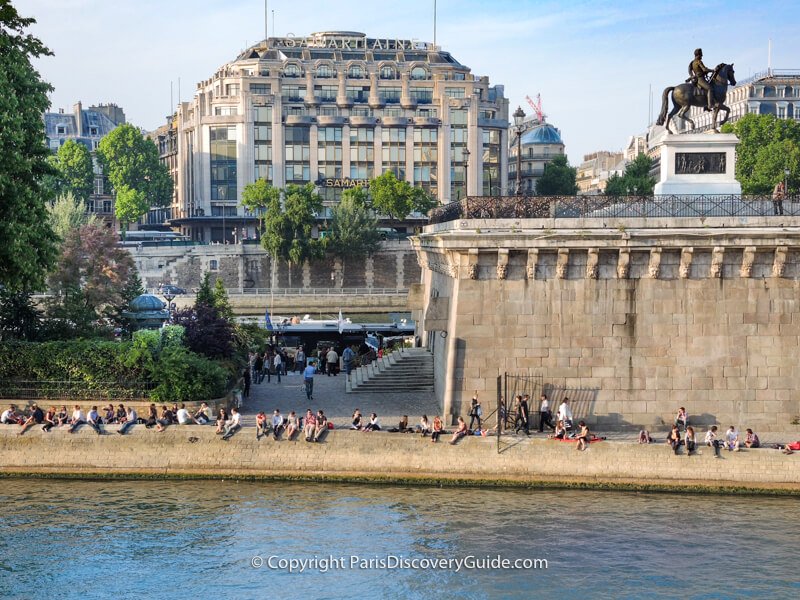
Picnic in Square du Vert-Galant
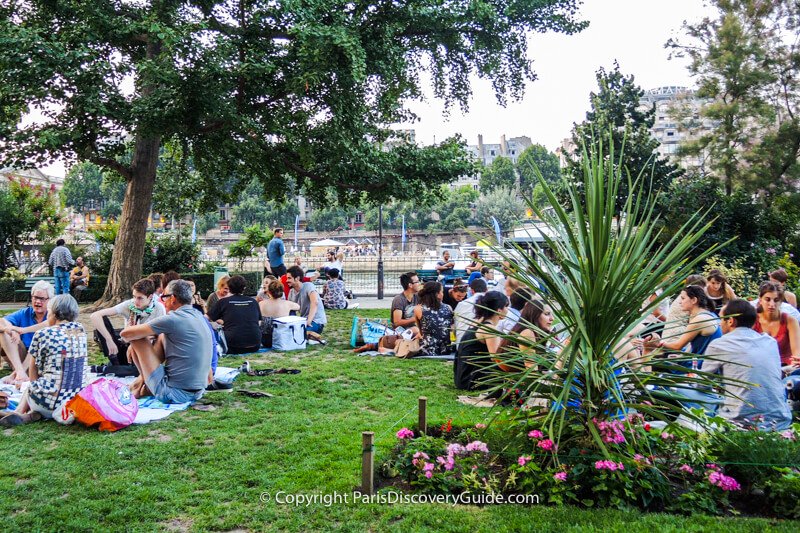
To reach Square du Vert-Galant, descend the rather steep set of stairs behind the statue of Henri IV.
You're near the spot where Jacques de Molay, the last Grand Master of the Knights Templar, was burned to death in front of a large crowd in 1314 before the garden existed.
Bonus points if you can find a small bronze plaque memorializing the event. Hint: look up toward the bridge.
Walk through the gate into the park, and you're now on a small spit of land at Île de la Cité's western tip formed by lining a natural sandbar with rock walls, or quais.
This is one of the city's loveliest almost-hidden gardens, and a popular site for picnics.
Want to enjoy a picnic of your own here? You can buy provisions by crossing the Pont Neuf bridge to the Saint-Germain-des-Prés neighborhood on the Left Bank. Walk along Rue Dauphine (the extension of the bridge), and you'll see numerous small places offering tasty carryout and, of course, wine.
No corkscrew? Just ask the shopkeeper to take out the cork for you.
I also recommend taking something to sit on because the grass here always feels damp because you're not far above water level. I find that a small table cloth works well - you can find nice inexpensive ones made from heavy cotton at the larger Monoprix stores, and sometimes even cheaper ones at Hema. They make nice souvenirs once you get home.
Take Photos of the Pont Neuf Bridge to Display After You Return Home
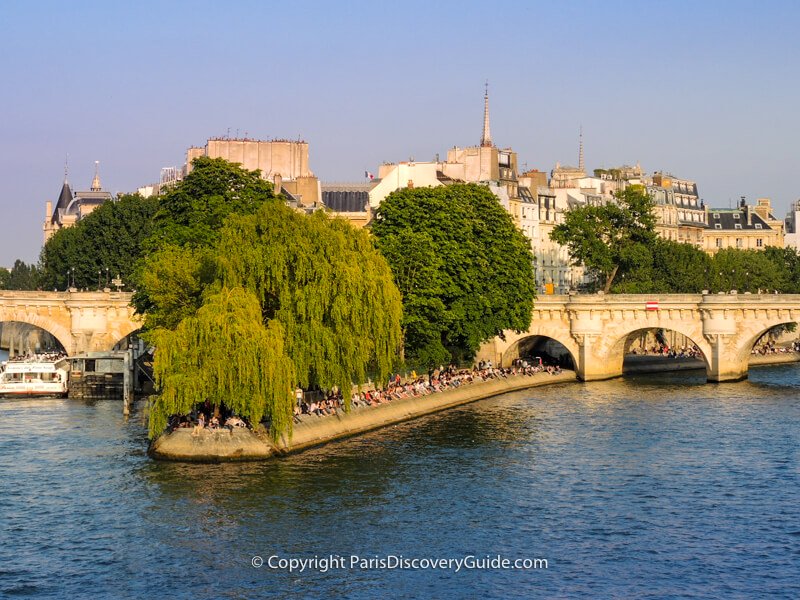
Pont Neuf opened to traffic in 1604 and is now the city's oldest bridge still in existence - ironic since its name means "new bridge."
Pont Neuf's arches hark back to the style used by Romans, and although it was the first bridge in Paris not to be lined with houses, it still attracted a lively crowd of thieves, murderers, gangs, hustlers, pickpockets, faith healers, prostitutes,entertainers, and tooth pullers - it even its own set of gallows for public executions.
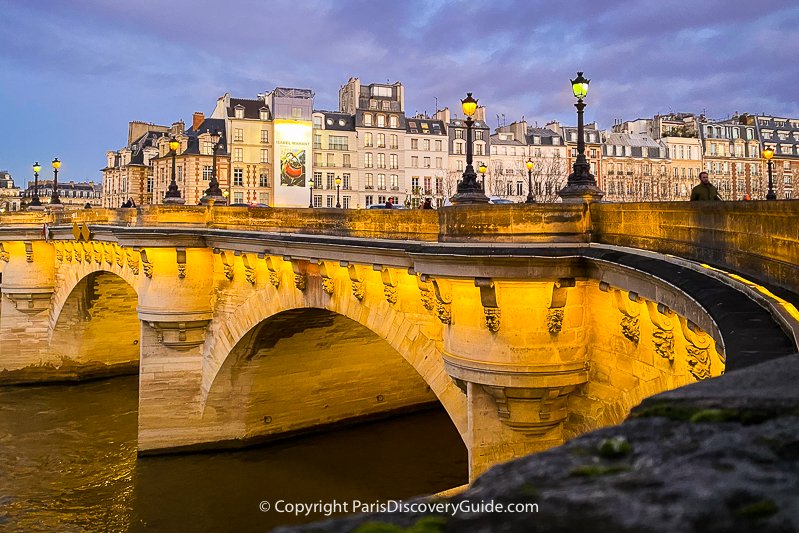
Try to imagine any of that happening today. Pont Neuf, now is quintessential Paris landmark, is one of the most photographed Paris bridges.
If you want to take some of your own, the best time to do so is usually in late afternoon when the light bounces off the mellow stone and turns everything golden.
Once you get home, choose your favorite and get it printed and framed. Even if you don't think you're a great photographer, you'll be amazed by how wonderful it looks on your wall.
Admire the Cité Metro Station's Art Nouveau Entrance
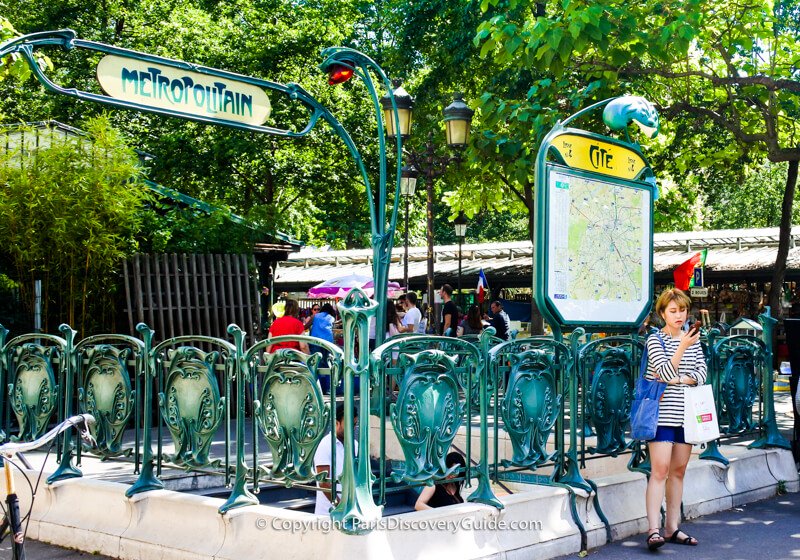
Although the Paris Metro boasts many different styles of entrances ranging from artistic to modern to slightly quirky, by far the most famous are the distinctive Art Nouveau masterpieces designed by architect Hector Guimard in the early 1900s.
Although 141 of Guimard's entrances once graced the city, only 86 of them remain. You can recognize them by their sinuous lines, organic motifs, and intricate details, evoking the Belle Époque era. Guimard crafted them from cast iron, and coated them with a signature shade of green paint similar to oxidized brass. The red glass globe lights are another defining feature.
To see one of the best Guimard entrances, stop by the Cité metro station, located in almost the exact center of the island. Bonus: you can then pop into Marché des Fleurs next to the station - a fantastic flower market.
Soak Up Colors in Marché aux Fleurs, Île de la Cité's Flower Market
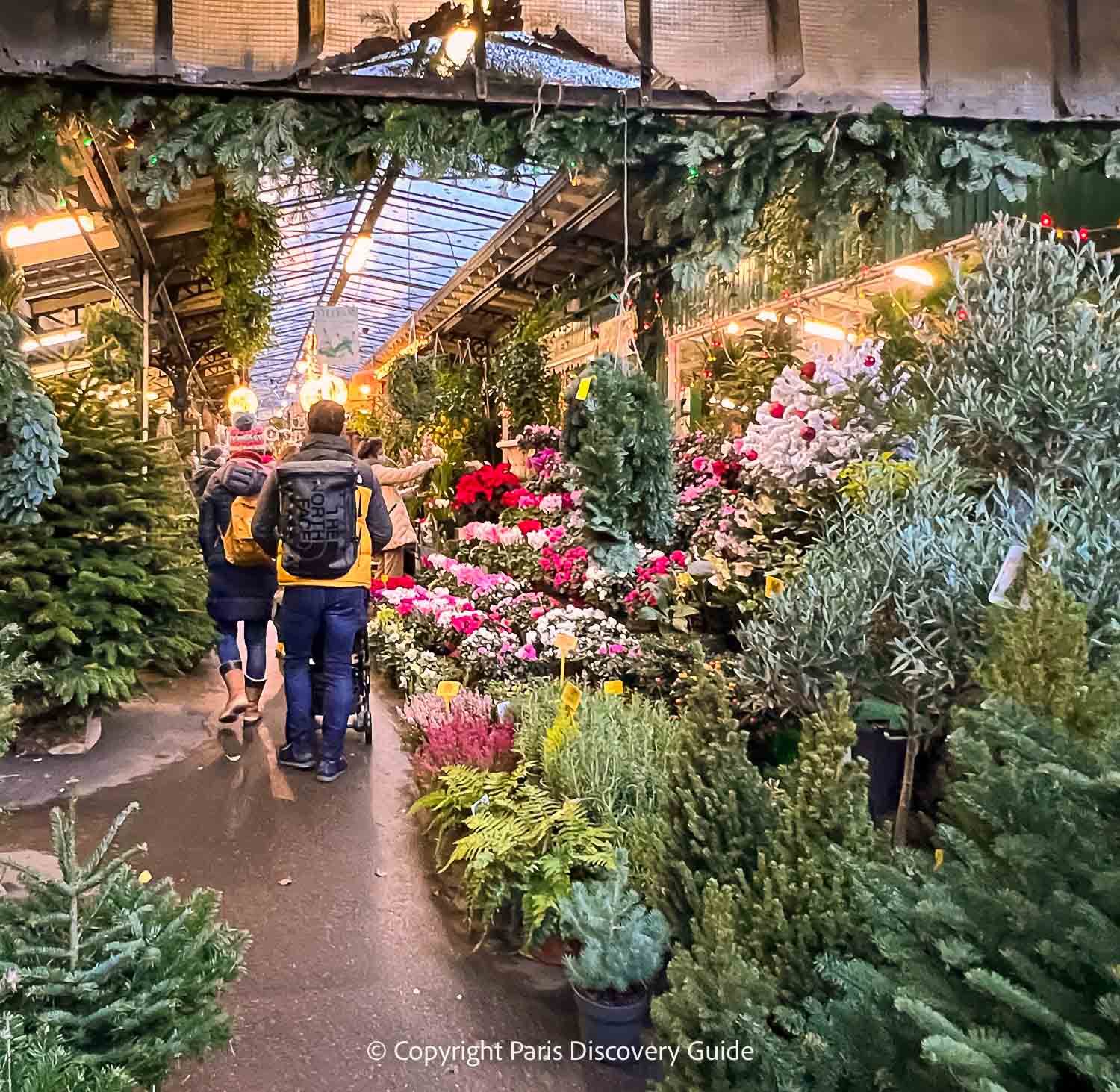
In a city filled with epic markets, Île de la Cité's Flower Market (Marché aux Fleurs) stands out. It's open every day from 8am-7:30pm, and has been delighting Parisians for over two centuries. Six green cast-iron pavilions with skylights make the market comfortable year-round, and outdoor tables accommodate even more vendors.
Stop by and admire the masses of colorful and fragrant offerings - every type of flower you can imagine. You'll also find all kinds of pots, tools, and other accessories. As Christmas approaches, the pavilions overflow with holiday arrangements and gifts.
Right now, the market is being renovated, which will continue until some time in 2028, although the worst of the construction seems to be finished. The market continues to be open with all 15 vendors still present while the work goes on.
10. Stand on Point Zero
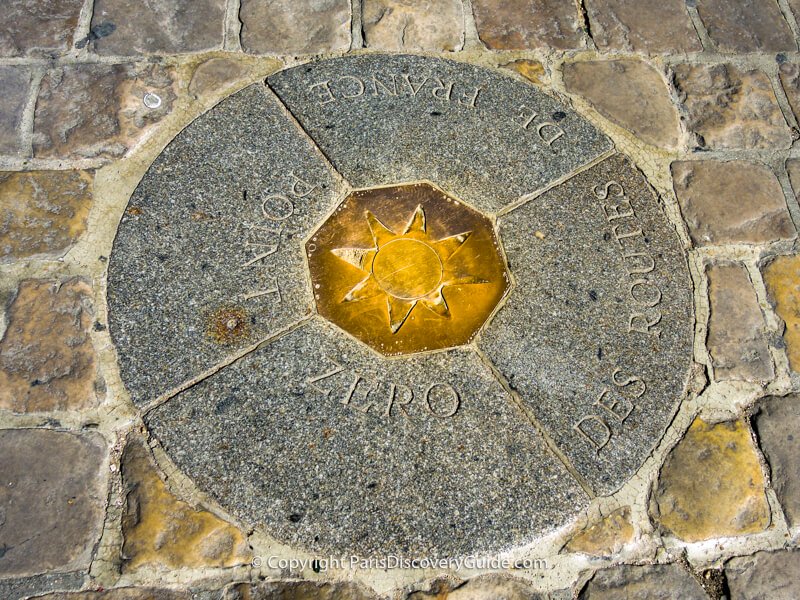
What it Point Zero?
Supposedly the Point Zero marker, a small bronze plaque set in granite amid the cobblestones in front of Notre Dame Cathedral, marks the exact center of the City of Paris.
Look at a map, and you may have your doubts about the "exact" part - but it is close to the center.
More important, the star in the marker's center is the point from which all distances in France are measured - which is why its exact name is Point Zéro des routes de France.
Don't be surprised if you have trouble finding the marker; it is small - less than 3 feet (1m) in diameter. Traditionally, Notre Dame's annual Christmas tree is placed directly on top of it - so here is a photo to help you locate the spot:
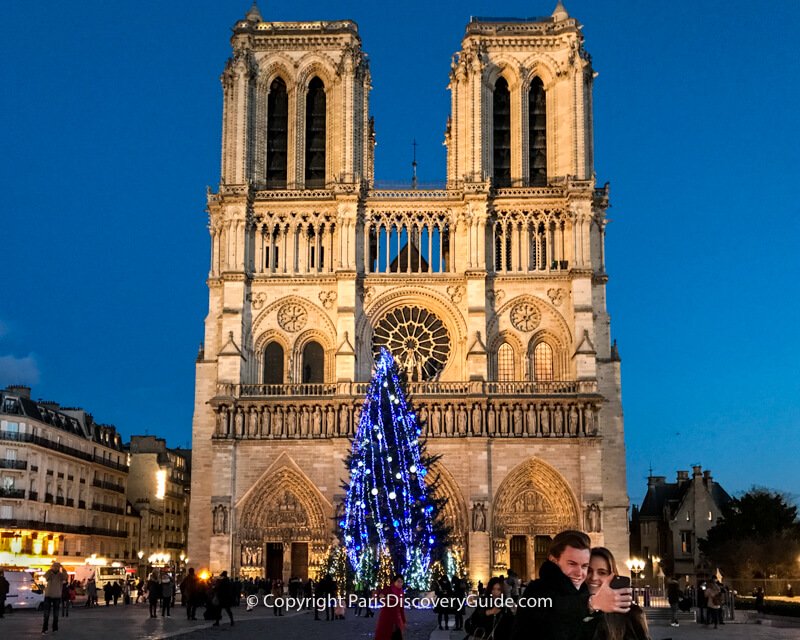 Notre Dame's Christmas Tree
Notre Dame's Christmas Tree Find out more about Christmas in Paris
Remember the Dead at the Memorial des Martyrs de la Deportation
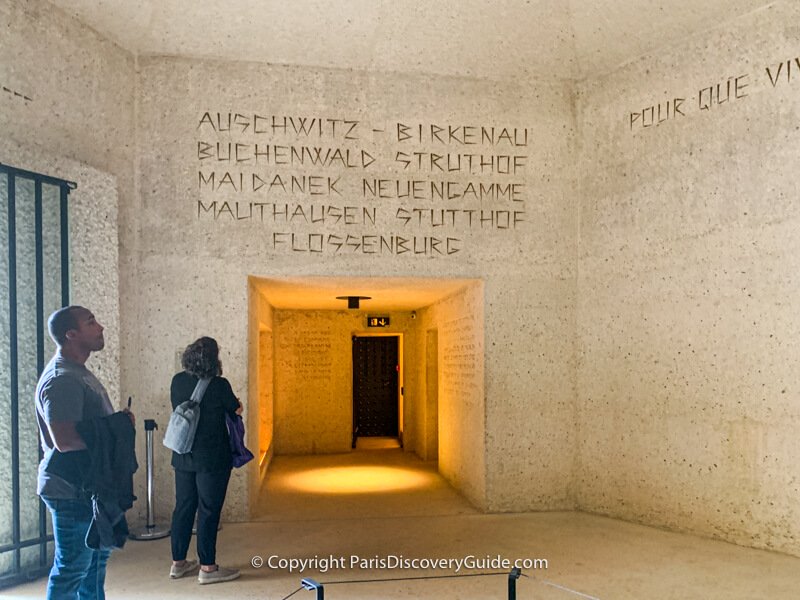
The Memorial to the Martyrs of the Deportation (Le Mémorial des Martyrs de la Déportation) commemorates the 200,000 people - French Jews, foreign Jews, Roma, political dissidents, refugees, communists, members of Résistance - deported by the Vichy France collaborationist government to Nazi death camps during World War II. You will find it located behind Notre Dame Cathedral on the site of a former morgue on the eastern tip of the island.
The Memorial is deliberately designed to be an immersive experience - so expect to perhaps feel claustrophobic, entrapped, and doomed as you descend the narrow stairs and walk through dimly-lit cells, just as deportees may have felt as they were conveyed out of France to concentration camps.
Most tourists miss this site. Don't be one of them. The Memorial is moving, evocative, thought-provoking, and if you visit, you'll remember it long after your trip is over.
Open daily from 10am-7pm from April through September, and 10am-5pm from October through March. Admission is free.
See Paris History at Crypte Archéologique
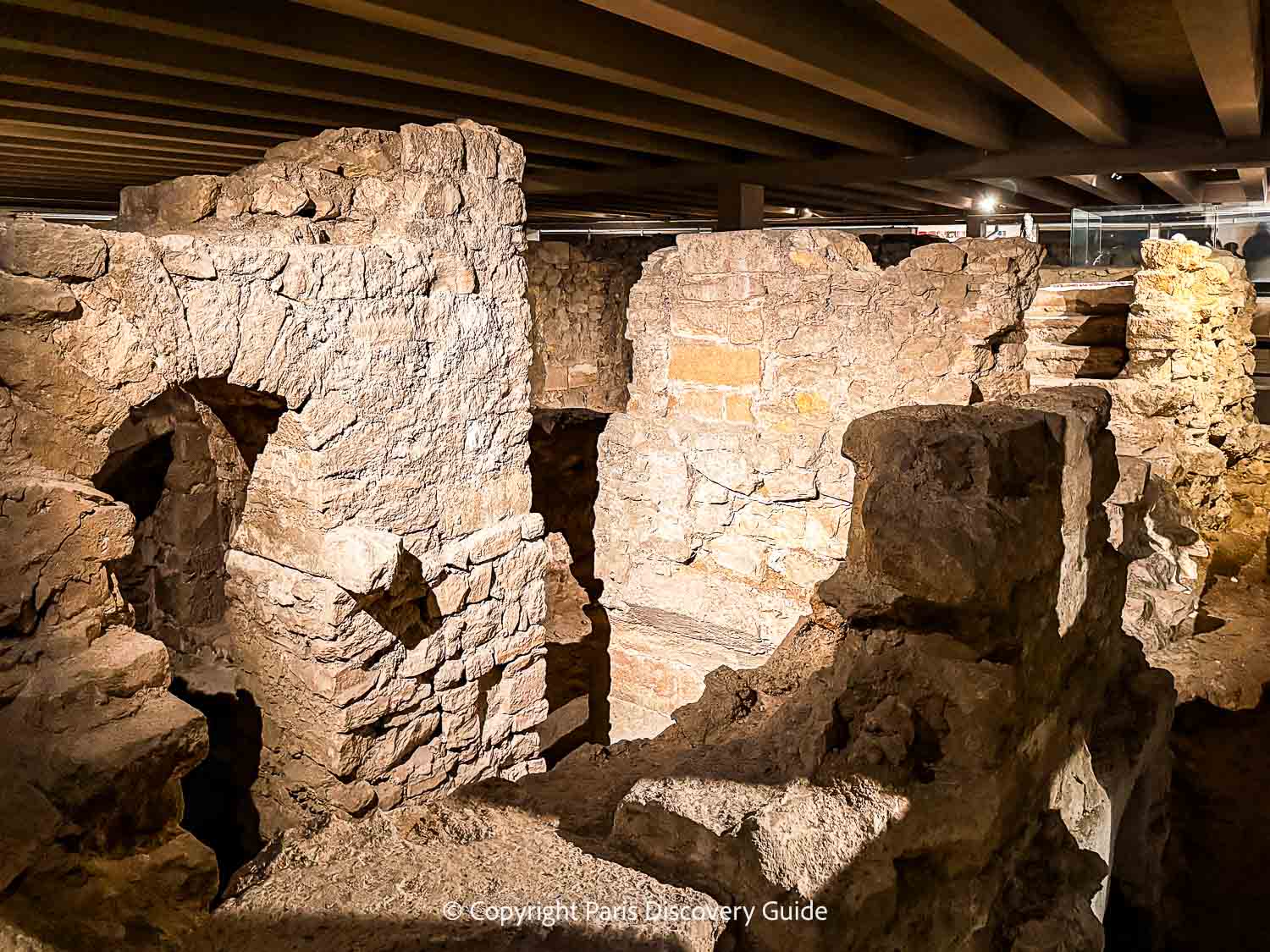
Crypte Archéologique started by accident back in the 1960s when an excavation for a parking lot under the large plaza (Parvis) in front of Notre Dame unearthed some unexpected discoveries: layers and layers of artifacts representing over 2,000 years of Paris history.
After archeologists, antiquarians, and other specialists arrived on the scene, preserved, sorted out, and identified the jumble of ruins, a new museum emerged.
My husband and I recently visited the museum on a whim - primarily to take refuge during a sudden rain storm - and stayed much longer than we expected due to the wealth of fascinating artifacts and excellent signage in French, English, and Spanish.
What can you see here? Exhibitions change every few years so what you see depends partly on what's on display at the moment. The current display features a large number of objects found in the Seine River around the island from prehistory to the present day.
Displays in the past have included remains of Roman baths and upscale Roman houses with forced-hot air heating syste, remnants of an ancient port, remains of an 18th century orphanagems ("hypocausts"), medieval walls, ramparts, wells, and house foundations - and lots more, including descriptions of the first nearby human settlements by Neanderthals dating back some 300,000 years ago.
Fortunately, 3D renditions help you make sense of what you're looking at: a panoramic view of how Paris has recreated itself through the centuries.
Tickets: There's never much of a line, so get tickets at the entrance. Free entrance if you have a Paris Museum Pass.
See Charlemagne on Horseback
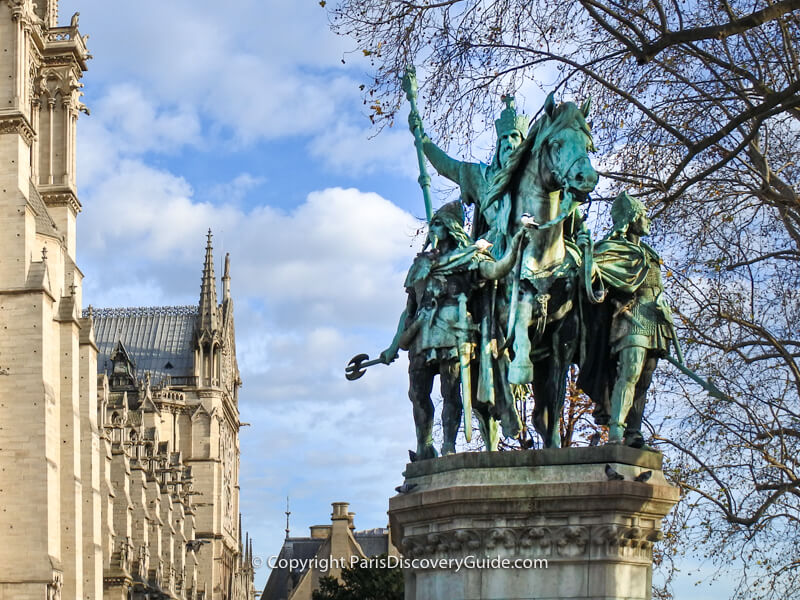
Like most of the older historical Paris neighborhoods, Île de la Cité has more than its share of statues of famous people, but the most imposing and best known is a bronze statue of Charlemagne, crowned King of the Franks in 800, on horseback with his guards Olivier and Roland.
The statue is located on a pedestal on the south side of the plaza (ie, toward the river) in front of Notre Dame. The statue is fairly magnificent, particularly if you're interested in Charlemagne - but the main reason you may want to be familiar with what it looks like is because many tour groups tell you to meet by it - so take a good look at the photo.
View Île de la Cité from a Different Perspective on a River Cruise
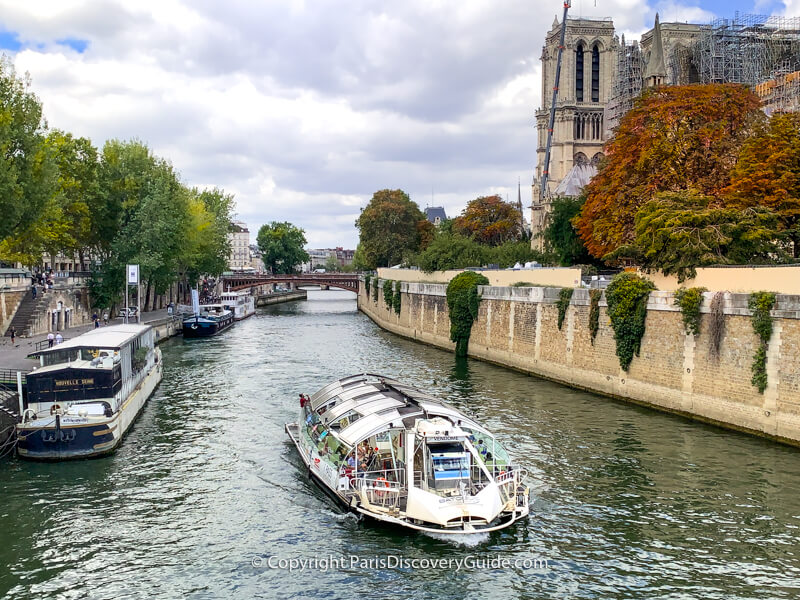
Walking around Île de la Cité and exploring it on foot lets you appreciate its many attractions close up - but viewing it during a Seine River sightseeing cruise gives you a whole different perspective.
You'll get up-close views of Square du Vert-Galant and the Pont-Neuf Bridge, see the full expanse of the Conciergerie and all its medieval towers, and have some of the best views of Notre Dame.
And of course, you'll see much more, as so many of Paris's most famous landmarks and monuments are located along the river.
Getting There: Île de la Cité Location & Map
Location: Middle of the Seine River, between the Right and Left Bank; Île de la Cité straddles the 1st and 4th Arrondissements
Walking: Walking across any of the bridges to reach Île de la Cité: Pont Neuf, Pont Au Change, Pont Notre Dame, Pont d'Arcole, Pont au Double, Petit Pont, Pont de l'Archevêché, Pont Saint-Louis, Pont d'Arcole
Metro: Line 4, Cité station
Batobus: (Notre Dame or Hotel de Ville stop) - Get Batobus hop on hop off river cruise tickets
Bus: Lines 21, 38, 47, 58, 70, 75, 96; this map shows where they cross the island:
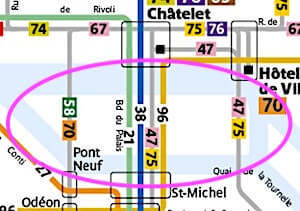
Interactive Map Showing Top Attractions on Île de la Cité
Another Map Showing Île de la Cité
If you prefer non-interactive maps, this one created by Paris 16 and OpenStreetMap contributors show the island and nearby areas on the Right and Left Banks:
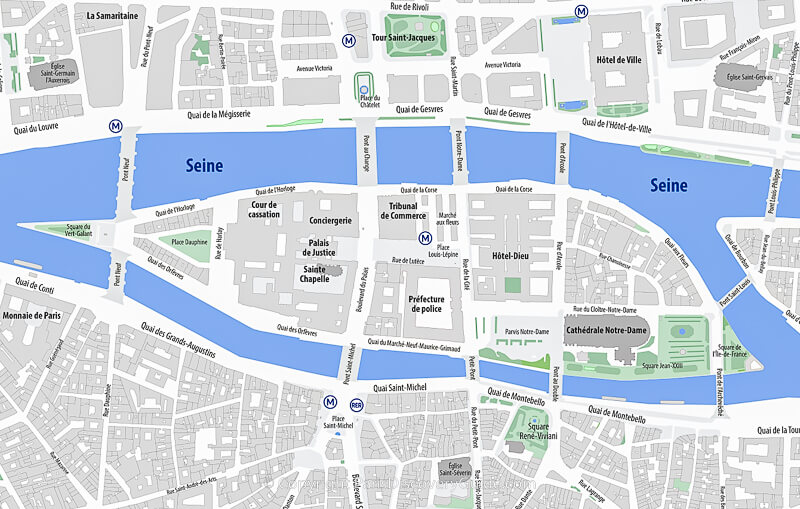
Best Hotels & Apartments near Île de la Cité
Although there are no hotels on Île de la Cité, you'll find plenty of wonderful choices just a few minutes' walk away on the Right Bank, Left Bank, and adjacent island, Île Saint-Louis. Here are a few to consider
- Hôtel Europe Saint Séverin Paris - Small Latin Quarter hotel close to Notre Dame; request a room with a balcony!
Find best rates - Hotel Saint-Louis en l'Île - Highly rated 3-star boutique hotel with air conditioning and an elegant ambiance on nearby Île Saint-Louis near Notre Dame - Book now
- Citadines Saint Germain des Prés - Serviced apartments (studios and larger) in a top-notch Right Bank location across from Île de la Cité and the Conciergerie
Book best deals - Relais Hôtel du Vieux Paris - Charming 4-star boutique hotel in a historical 15th century building in the Latin Quarter - just a quick walk across the Pont Saint-Michel bridge to the Conciergerie
Find best rates - Hôtel Left Bank Saint Germain - Charming 3-star boutique hotel with just 31 rooms in an 18th century building in fashionable Saint-Germain-des-Prés, just a 5 minute walk from Conciergerie - See best deals
Want more suggestions? Check out:
- Hotels near Notre Dame - Recommendations for accommodations on Ile Saint Louis and across the river in the Latin Quarter
- 1st Arrondissement Paris Hotels - Find best places to stay across the river in this convenient-to-everrything Right Bank district
Île de la Cité does have a few high end and luxury apartments such as Residence Lancaster available for short-term rentals that are definitely worth considering if they fit your budget.
Others include the Dauphine Apartments at 25 Place Dauphine, a historical 1610 building, and are rented through Paris Perfect.
Guest Apartment Services which handles rentals for a couple of apartments on Ile de la Cité as well as several others on adjacent Ile Saint-Louis.
First time visitor to Paris? Find out about the best neighborhoods to stay in
Map Showing More Paris Hotels & Apartments near Île de la Cité
Use this Paris hotel map to find more hotels and apartments on Île de la Cité. Enter your dates to see what's available and find the cheapest rates:
Booking.comCheck out the newest Paris hotels
Where to Eat on Île de la Cité: Bistros, Brasseries, Cafes, Raclette, & Creperies
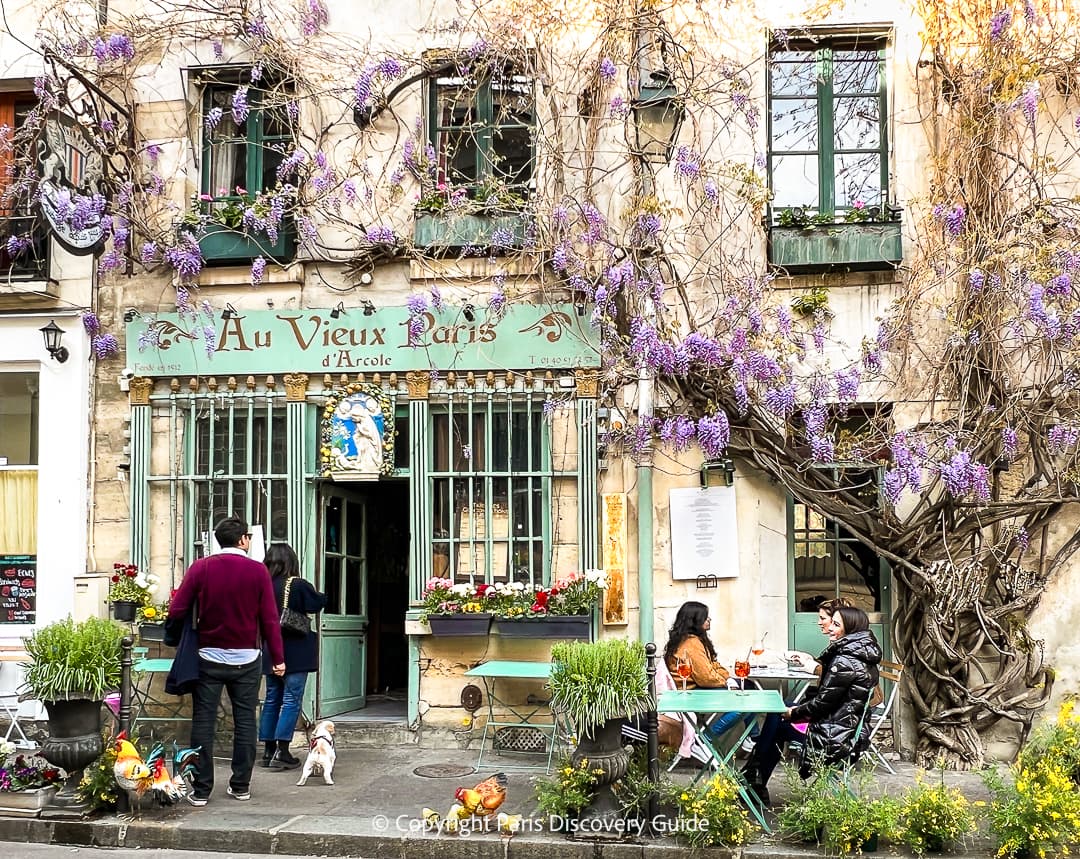
- Place Dauphine - Many small restaurants, bistros, and cafes - all are good, so check out the menus and choose the one you like best
- Across the street (Boulevard du Palais) from Sainte Chapelle and the Conciergerie: Les Deux Palais - favorite spot for burgers, steak-frites, salads, omelettes, and other traditional brasserie fare
- Near Notre Dame - If you're facing the cathedral, you'll find lots of casual places along the street on its left - some may seem rather touristy, but the food is generally quite good
- Au Vieux Paris d'Arcole (24 Rue Chanoinesse) - Although perhaps best known for its lovely display of wisteria blooms during April, this small cafe offers tasty traditional food near Notre Dame
- Île Saint-Louis - Walk across Pont Saint-Louis and walk down Rue Saint-Louis en l'Île where you'll see a dozen or two choices including a couple of creperies - all are good. After your meal, head to Berthillon at #31 and indulge in the most famous ice cream in Paris
- Latin Quarter - If you have a craving for raclette, head to Le Marmiton de Lutèce (6 Rue Saint-Severin) in the Latin Quarter, about a block from the river; to get there, walk across Petit Pont bridge, turn right onto Rue Severin, and you'll see Le Marmiton almost immediately on your right
More to Explore near Île de la Cité
You're in the center of Paris, surrounded by so much to see and do! Here are just a few suggestions for nearby famous as well as lesser-known attractions:
- The Louvre - Walk across the Pont Neuf bridge to the Right Bank, and the famous museum will be to your left. Book a skip-the-line ticket online or join a tour - you can find out about our favorite small-group tour experience here. After you've had your fill of art, architecture, and culture, head to Tuileries Gardens to the west of the Louvre and relax by the beautiful fountain.
- The Marais - The best-preserved old medieval parts of the city, and a favorite of fashionistas who love the international and Parisian boutiques along and near Rue des Francs Bourgeois and Rue des Rosiers. Treat yourself to a falafal at L'As du Fallafel (34 Rue des Rosiers) in the heart of this traditional Jewish neighborhood. Visit Paris's Holocaust museum, Mémorial de la Shoah, or the Picasso Museum. See some lovely little-known parks and gardens on our Rue Payenne walking tour.
- The Latin Quarter - Want to see more medieval treasures, including the famous Lady and the Unicorn tapestries? Get your Middle Ages fix at the Cluny Museum (use a Paris Museum Pass for free entrance) which also has well-preserved Roman baths. Or go back even farther in time and visit a well-preserved Roman arena, Arènes de Lutèce.
- The Rest of the 1st Arrondissement - Île de la Cité is only a small part of the attraction-packed First Arrondissement. Find about all the other fascinating places to see and things to do in this historical part of Paris.
More Articles about Top Paris Attractions
- More historical Paris churches where you can hear classical music concerts
- How to get fast entry to top Paris attractions with skip-the-line tickets
- Easy day trips from Paris to Versailles, Giverny, Mont Saint Michel, D-Day Normandy Beaches, Disneyland, London, Bruges, & more
- How to get Eiffel Tower tickets without waiting in long lines


